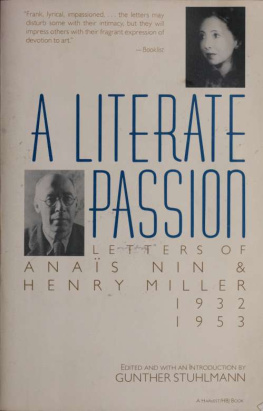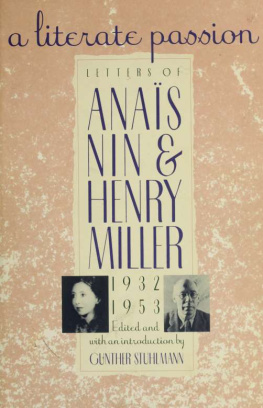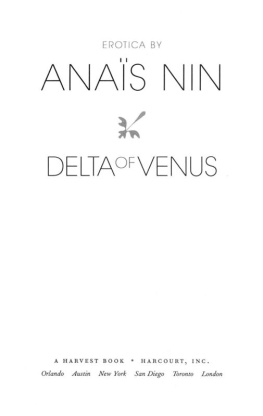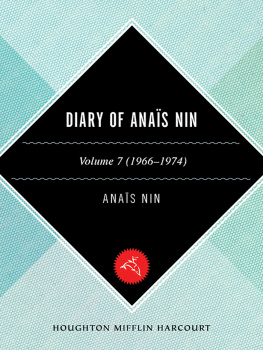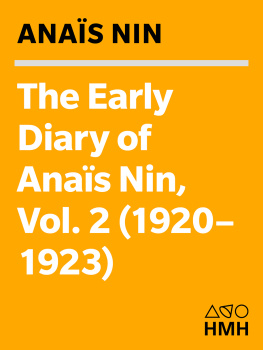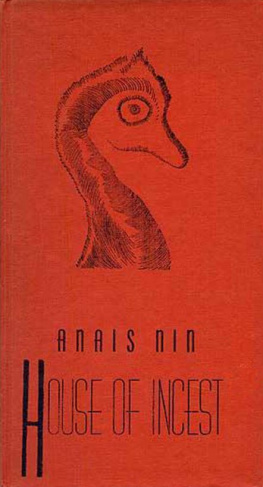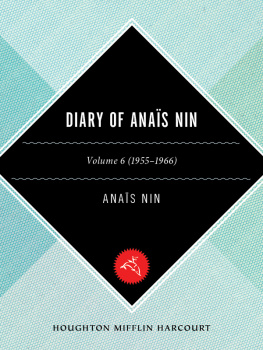HBJ
A Harvest/HBJ Book
Harcourt Brace Jovanovich, Publishers
San Diego New York London
Copyright 1974 by Anas Nin
Preface copyright 1974 by Gunther Stuhlmann
All rights reserved.
No part of this publication may be
reproduced or transmitted in any form
or by any means, electronic or mechanical,
including photocopy, recording,
or any information storage and
retrieval system, without permission in
writing from the publisher.
Requests for permission to make copies of
any part of the work should be mailed to:
Copyrights and Permissions Department,
Harcourt Brace Jovanovich, Publishers,
Orlando, Florida 32887.
Library of Congress Cataloging in Publication Data (Revised)
Nin, Anas, 1903-1977.
The diary of Anas Nin.
(A Harvest/HBJ book)
CONTENTS: [1] 1931-1934.[2] 1934-1939. [5]
1947-1955.
1. Nin, Anas, 19031977Biography.
I. Stuhlmann, Gunther, ed. II. Title.
PS3527.I865Z5 1969 818'.5'203 77-2085
ISBN 0-15-626030-1
Printed in the United States of America
First Harvest edition 1975
E F G H I J
Preface
With the publication of this fifth volume drawn from the original diaries of Anas Nin we are gaining an ever larger view of this unique and massive literary undertaking. Each one of the published volumesself-contained yet contiguousexposed a fresh segment, a new chapter in this ongoing "novel" of a remarkable life. We saw Anas Nin emerge in Paris as a writer and catalyst to Henry Miller, Antonin Artaud, Dr. Otto Rank, and many others (193134); we followed her on a vibrant mission to the New World where her pursuit of psychoanalysis conflicted with her survival as a writer (193439); we watched the end of her "romantic life" in Europe and her reluctant return to the United States (193944); and we observed her efforts to come to terms with her second exile in America (194447). Each publication brought to light another portion of that grand store of varicolored, multishaped, multisized notebooks which, by 1947, amounted to some seventy-five handwritten volumes, a body of work that for years had defied all efforts at publication.
The present volume, drawn from the original diaries seventy-five to eighty-eight, and covering some eight years, to 1955, extends our total view of the Diary to a period of almost twenty-five years. From this vantage point we can discern the longer lines of growth and development. We can spot more easily the recurring themesconflicts, conditioned responses, emotional patterns, the lifelong efforts to shake off the past, to create a "livable" presentthat make up the essential warp and woof of Anas Nin's luminous tapestry. Beyond the individual event, the biographical fact, the nascent portrait, the captured high moment, the meditations and working notes, emerge deeper motivations, stronger connections. Indeed, the availability of all this material now may also explain the recent emergence of the first comprehensive critical studies of the published Diary.
The changes in tone and in the very function of the Diary, seen over a stretch of time, also seem more noticeable. What started out as an enticing "letter," a Scheherazade, to bring back the lost father, had turned in the 1930s into Anas Nin's "kief, hashish, and opium pipe," and, by 1955, was evolving into an ever more consciously applied artistic instrument: "I have settled down to fill out, round out the diary.... I write about the developments and conclusions which took place twenty years later. It all falls into place."
But the essentia] need for the Diary, the tenacious, often joyous interplay between the Diary and its creator, which survived all moments of peril, remains. ("When I don't write I feel my world shrinking, I feel I am in a prison.") The urge to preserve is as strong as ever. ("The diary gave me a frightening mistrust of memory. Memory is a great betrayer. Whenever I read it, I find it different from the way I remembered the scenes and the talk.") The intensity of her struggle to resolve persistent problems, to shake off neurosis, to gain a firm hold on the "secret of personal freedom," which is a secret of creation, still reverberates through these pages.
Her enthusiastic response to new-found color and beauty in Mexico ("I felt a new woman would be born there") and her retreat from the arid frenzies of New York City to rustic serenity in California still do not resolve the conflict between repose(withdrawal?) and activity(succumbing to the outside world?). "This year," she writes, late in 1950, "the diary almost expired from too much traveling, too much moving about, too many changes. I felt pulled outward into activity, I did not want to meditate and examine...." Using the two symbolic poles of New York and California, she feels "there must be a third way of life which I have to create myself."
The present, to her, is still unbearable at times. "I feel suffocated in my life," Anas Nin confides to her new psychiatrist in 1952, "overwhelmed by the demands put on me." The past still beckons as the paradise lost: "When I imagine the kind of life I like best, it was my bohemian life on the houseboat in Paris." But she also recognizes the past overshadowed by the father's critical eye, by the emotional camera lens that forever seemed to dog her steps. "That eye had to be exercised, or else, like that of a demanding god, pleased. I had to labor at presenting a pleasing image." The shedding of disguises is at the core of growing, and she knows that it takes courage "to be myself, rather than disguise myself." There is, after all, an Anas "who could love an ordinary tree which was neither symbolic, nor exotic, nor rare, nor historic, nor unique."
In a letter to Maxwell Geismar, in 1955, she measures her own progress ("I don't live here any more, I live in the future") toward that undisguised Anas:
This year I finally achieved objectivity, very difficult for a romantic. The divorce from America, as I call it, was painful, but has proved very creative and liberating. It was like breaking with a crabby, puritanical, restrictive and punitive parent. As soon as I overcame the hurt, I began to write better than ever. America, for me personally, has been oppressive and destructive. But today I am completely free of it. I don't need to go to France, or anywhere. I don't need to be published. I only need to continue my personal life, so beautiful and in full bloom, and to do my major work, which is the diary. I merely forgot for a few years what I had set out to do.
The Diary, we all know now, is indeed Anas Nin's major work. When she took up her pen on that first miserable journey into exile, at the age of eleven, she tried, by the sheer magic of her words, to bring back a golden past. She tried to lasso that universal dream of a father who will hold us safe from the realities of the world, from loss, separation, indifference, from the pain of growing up and dying and forgetting. She has never given up trying. Trusting forever in the magic of the word ("The role of the writer is not to say what we can all say but what we are unable to say"), she created, in the Diary, an instrument that shaped the very contours of her own life.
In answer to the question"Why does one write?"Anas Nin once replied: "... It is a world for others, an inheritance for others ... in the end. When you make a world tolerable for yourself you make a world tolerable for others."
G UNTHER S TUHLMANN
New York, N.Y.
November, 1973
[Winter, 19471948]
Acapulco, Mexico.
I am lying on a hammock, on the terrace of my room at the Hotel Mirador, the diary open on my knees, the sun shining on the diary, and I have no desire to write. The sun, the leaves, the shade, the warmth, are so alive that they lull the senses, calm the imagination. This is perfection. There is no need to portray, to preserve. It is eternal, it overwhelms you, it is complete.
Next page

